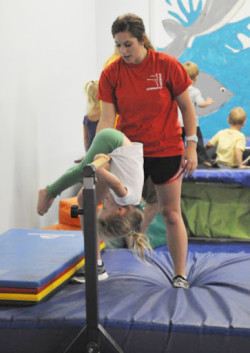 From looping in and over the uneven bars to defying gravity on the spring floor, gymnastics is a sport that requires plenty of safety precautions. According to coaches from Everest Gymnastics, failure to maintain proper procedures in the gym may result in injuries that can stop an athlete in their tracks. We recently sat down with these gymnastics experts to find out more.
From looping in and over the uneven bars to defying gravity on the spring floor, gymnastics is a sport that requires plenty of safety precautions. According to coaches from Everest Gymnastics, failure to maintain proper procedures in the gym may result in injuries that can stop an athlete in their tracks. We recently sat down with these gymnastics experts to find out more.
Q: Good evening. We would like to talk about gymnastics today, and specifically what types of safety gear and procedures are used during practice.
Everest Gymnastics: There are many different types of equipment. What pieces are used depends on the event being practiced or performed.
Q: Let’s start with the uneven bars.
Everest Gymnastics: There are three main pieces of equipment that gymnasts use when they are on the bars. These are wrist straps, grips and guards. These work to improve the athlete’s ability to maintain a proper hold so they do not slip and fall.
Q: What is the difference between a grip and a wrist strap?
Everest Gymnastics: A wrist strap goes around the wrist to keep it stable. The grip cradles the inside of the palm and reduces slipping. Often, the grip has finger holes and is worn a bit like a partial glove.
Q: Without these pieces, is it possible to improve an athlete’s grip and avoid blisters?
Everest Gymnastics: It is to some extent. Some athletes choose to use gauze or sports tape instead of leather grips. These are effective for beginning gymnasts that have yet to master more physically demanding routines.
Q: Moving on to the balance beam. We have noticed that gymnasts sometimes wear shoes instead of going barefoot. Is this also a safety precaution?
Everest Gymnastics: Our gym does not utilize these, but they can be used as a safety precaution. Usually, when you see someone on the balance beam and they are wearing shoes, they have rubber soles that keep their feet from slipping off the beam. Similarly, shoes are also used on the vault. These have a reinforced toe, which helps disperse the pressure experienced by the athlete while landing.
Q: How do spotting belts work?
Everest Gymnastics: A spotting belt is an apparatus that is worn around the waist. It looks similar to what you would wear on a bungee trampoline. It is connected to two cables, which are either attached to the ceiling or to a harness system. The purpose of the spotting belt is to keep the athlete from landing with extreme force while practicing difficult moves. It is essentially a safety harness that can be worn while the athlete improves their form.
Q: We understand that Everest Gymnastics has a few requests for parents and students that are intended to ensure safety. Can you tell us a little about those?
Everest Gymnastics: Before each class or training session begins, we want our students to stretch. While it seems very simple, this gives the muscles an opportunity to become aware that more strenuous activity is on the way. We also encourage our students to get a sports physical and to let their coaches know anytime they are uncomfortable or unsure of themselves.
Q: It sounds like you guys take safety seriously.
Everest Gymnastics: Absolutely. Our students are the heart of Everest Gymnastics, and we will do anything it takes to make sure they are safe and have the tools they need to remain so throughout their gymnastics training.





